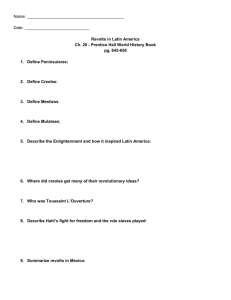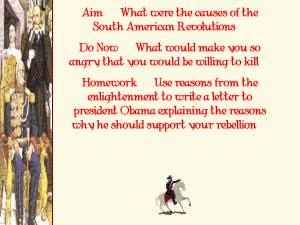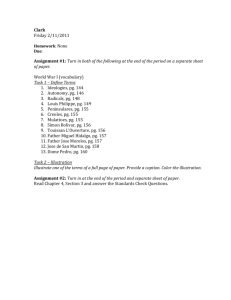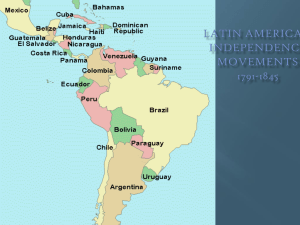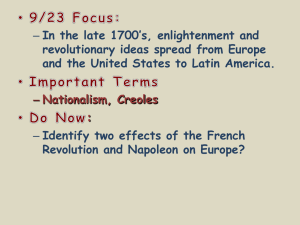Latin American Revolutions: 1750-1900 Worksheet
advertisement
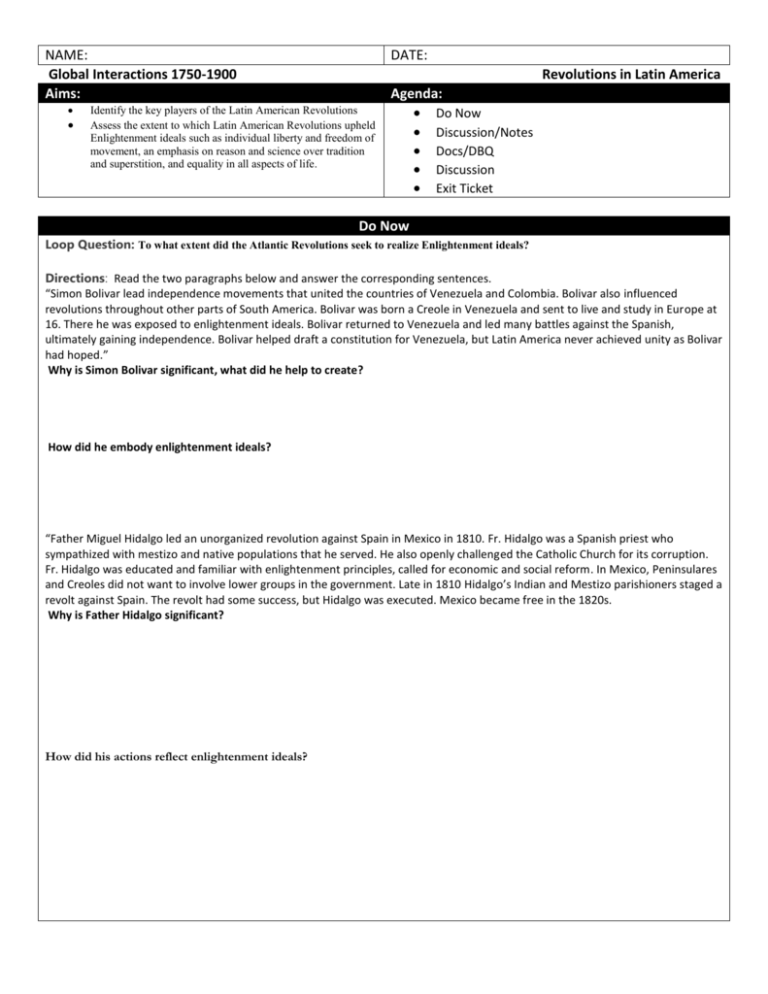
NAME: Global Interactions 1750-1900 Aims: DATE: Revolutions in Latin America Identify the key players of the Latin American Revolutions Assess the extent to which Latin American Revolutions upheld Enlightenment ideals such as individual liberty and freedom of movement, an emphasis on reason and science over tradition and superstition, and equality in all aspects of life. Agenda: Do Now Discussion/Notes Docs/DBQ Discussion Exit Ticket Do Now Loop Question: To what extent did the Atlantic Revolutions seek to realize Enlightenment ideals? Directions: Read the two paragraphs below and answer the corresponding sentences. “Simon Bolivar lead independence movements that united the countries of Venezuela and Colombia. Bolivar also influenced revolutions throughout other parts of South America. Bolivar was born a Creole in Venezuela and sent to live and study in Europe at 16. There he was exposed to enlightenment ideals. Bolivar returned to Venezuela and led many battles against the Spanish, ultimately gaining independence. Bolivar helped draft a constitution for Venezuela, but Latin America never achieved unity as Bolivar had hoped.” Why is Simon Bolivar significant, what did he help to create? How did he embody enlightenment ideals? “Father Miguel Hidalgo led an unorganized revolution against Spain in Mexico in 1810. Fr. Hidalgo was a Spanish priest who sympathized with mestizo and native populations that he served. He also openly challenged the Catholic Church for its corruption. Fr. Hidalgo was educated and familiar with enlightenment principles, called for economic and social reform. In Mexico, Peninsulares and Creoles did not want to involve lower groups in the government. Late in 1810 Hidalgo’s Indian and Mestizo parishioners staged a revolt against Spain. The revolt had some success, but Hidalgo was executed. Mexico became free in the 1820s. Why is Father Hidalgo significant? How did his actions reflect enlightenment ideals? Document Based Question and Documents Directions: Mark up the texts below and then respond to the DBQ prompt below for each document with evidence. DBQ Prompt: Analyze the factors that lead to the various revolutions in Latin America. (Video Question Answers) 1. Document One Source: Father Hidalgo 1810, The Virgin of Guadalupe Speech. Outside Hidalgo’s home on the eve of the Revolution. Historical Background: The Virgin of Guadalupe is a reference to the Virgin Mary, an important figure in Roman Catholic religion. , My friends and countrymen: neither the king nor tributes exist for us any longer. We have borne this shameful tax, which only suits slaves, for three centuries as a sign of tyranny and servitude; [a] terrible stain which we shall know how to wash away with our efforts. The moment of our freedom has arrived, the hour of our liberty has struck; and if you recognized its great value, you will help me defend it from the ambitious grasp of the tyrants. Only a few hours remain before you see me at the head of the men who take pride in being free. I invite you to fulfill this obligation. And so without a patria nor liberty we shall always be at a great distance from true happiness. It has been imperative to take this step as now you know, and to begin this has been necessary. The cause is holy and God will protect it. The arrangements are hastily being made and for that reason I will not have the satisfaction of talking to you any longer. Long live, then, the Virgin of Guadalupe! Long live America for which we are going to fight. Document Two Source: Simon Bolivar, The Jamaica Letter, 1815. Historical Background: Simon Bolivar was born to a wealthy family from Spain in Venezuela. He fought against Spain for many years. He is known as the George Washington of Latin America. His efforts were successful in ending Spanish rule, he failed to achieve the dream of a united country, like in North America. In this well-known letter, Bolivar makes the case for independence for his continent. “ The habit of obedience, a commerce of shared interests, knowledge and religion, mutual goodwill; a tender concern for the birthland and glory of our ancestors; in brief everything that constituted or hopes came from Spain…Today the opposite is true. Death, dishonor, everything harmful threatens us and makes us fearful. That wicked stepmother is the source of all our sufferings.” Document Three Source: Simon Bolivar, 1810, Jamaica Letter “We were…absent from the universe in all things relative to the science of government and the administration of the state. We were never viceroys, never governors, except in extraordinary circumstances; hardly ever bishops or archbishops; never diplomats; soldiers only in lower ranks, nobles but without royal privileges. In short, we were never leaders, never financiers, hardly ever merchants… Document Four Strayer, Spanish American Revolutions 1810-1825 “…The answer to this dilemma was found in nativism, which cast all of those born in the Americas---creoles, Indians, mixed-race people, free blacks---as Americanos, while the enemy was defined as those born in Spain or Portugal…many creole whites and mestizos saw themselves as Spanish and because great differences or race, culture, and wealth separated the Americanos. Nonetheless, nationalist leaders made efforts to mobilize people of color into the struggle with promises of freedom, the end of legal restrictions, and social advancement. Many of these leaders were genuine liberals (those who believed in independence from Spain), who had been influenced by the ideals of the enlightenment, the French Revolution and Spanish liberalism… in the long run few of these promises were kept…certainly Native Americans and slaves benefitted little from independence…” EXIT TICKET NAME: Directions: Answer each question. DATE: 1. Which of the following explains why Creoles took leadership of many Latin American Revolutions? a. Creoles resented Peninsulare control and power in the Spanish colonies b. Since creoles controlled land and the lives of natives and mestizo ,they were in the best position to be an advocate for underrepresented minorities. c. Creoles had exposure to enlightenment teachings in Europe, which inspired them to revolt. d. Creoles were offended at the Spanish monarchy’s constant attempts at raising taxes on people of their colonies. Creoles were also influenced by the ideals of the European enlightenment. 2. Name two of the leaders behind the revolutions in South America. 3. Compare and contrast the American, French, and Latin American Revolutions. 4. Which of the following is true of the Latin American Revolutions? a. Latin American countries united under one common government. b. The Latin American revolution inspired great permanent changes to the thought processes of Peninsulares and the Spanish monarchies. c. The race or class structure of Latin American societies did not change because of them d. Natives were finally afforded rights equal to those enjoyed by creoles and peninsulares.

